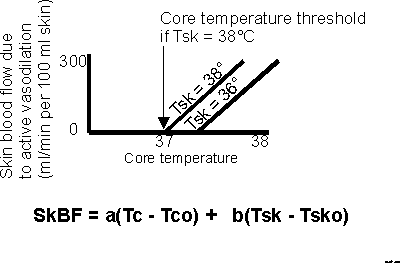
Research with human subjects has shown what you might expect, i.e., the thermoregulation system is more complicated than a simple proportional controller. However, at least in some regions of control, its behavior compares to that of a dual-input proportional controller. In such systems, two control loops feed back information on temperature to the functional unit that controls effector output.

This graph and equation illustrate dual control based on research findings on control of skin blood flow in the hyperthermic zone where active vasodilation in the skin occurs along with sweating. Two research groups independently arrived at descriptions like this in experimental work in the 70's. It was clear that skin temperature was acting as an independent influence on this effector. This is expressed in the equation which says that the effector output is the sum of independent contributions driven, respectively, by core temperature and by skin temperature.
In order to plot a function of two variables, we have resort to contour plots, i.e. a series of lines each of which represents the relationship between the dependent variable and one of the independent variables for a constant level of the other independent variable. In the graph, one line is the relationship between skin blood flow and core temperature if skin temperature is 36C, the other for skin temperature at 38C.
In principle, if you could hold skin temperature constant at 38 degrees and gradually elevate core temperature from a low level, this vasodilator response would first occur at a certain threshold and increase proportionately thereafter.
Also in principle, you could repeat the experiment with skin temperature constant at 36 degrees and you would see the same proportional relationship once you passed the threshold, but this core temperature threshold would be at a higher level. That is because, at this lower skin temperature, the skin temperature input makes a smaller contribution.
We have actually performed experiments like this at a fixed skin temperature in an investigation of the core temperature threshold for sweating at a skin temperature of 38 degrees. We found that we could reproduce the threshold rather accurately when we held skin temperature constant in successive cycles of core temperature change.
For a quantitative illustration of how the numbers work out in dual control, click here for the page that uses the example of control of sweat rate to show the same effector output level at two different combinations of core and skin tempearatures.
To go on in the sequence, click for the page that begins the topic of equilibrium core temperature in relation to skin temperature